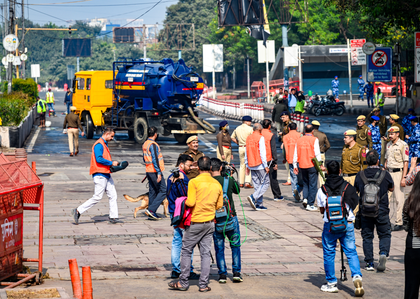Probe points to emerging transnational terror network as ISI pushes wider ops beyond J&K
By IANS | Updated: November 19, 2025 12:30 IST2025-11-19T12:25:58+5:302025-11-19T12:30:17+5:30
New Delhi, Nov 19 Security agencies probing the Delhi Red Fort blast are looking into the multiple foreign ...

Probe points to emerging transnational terror network as ISI pushes wider ops beyond J&K
New Delhi, Nov 19 Security agencies probing the Delhi Red Fort blast are looking into the multiple foreign links that played a key role in aiding the Jaish-e-Mohammed. While it has been established that the man who handled the attack was a Pakistani based out of Afghanistan, the possible role of Hamas too is not being ruled out.
Hamas leaders have been hobnobbing with terrorists of the Jaish-e-Mohammed and Lashkar-e-Taiba since 2023. Many Hamas leaders have been visiting Pakistan since October 7, 2023, the day the terror outfit launched a surprise attack on Israel that killed more than 1200 people.
Visits by the Hamas leaders have increased in the aftermath of Operation Sindoor. This was aimed at providing support to the terror groups that faced immense losses during the operation carried out by the Indian armed forces to avenge the Pahalgam attack.
Intelligence Bureau officials say that the setting up of the Faridabad module and also the Delhi blasts were the handiwork of the Jaish-e-Mohammed. While this terror group has been carrying out attacks in India for a very long time, a dangerous trend is now emerging. The ISI is involving foreign terror groups for India-based operations, the official said.
The Delhi strike may have been carried out by the Jaish-e-Mohammed, but this terror group had the tactical support of both the Islamic State and Hamas, officials pointed out. Before the Delhi attack, the Faridabad module members were planning on modifying drones to weaponise them. The idea was to use them as rockets to carry out attacks in many parts of the country. This, the investigators suspect, was a suggestion offered by the leaders of Hamas during their various visits to Pakistan.
Hamas is known to operate in this fashion and hence could have passed on ideas to the Jaish-e-Mohammed regarding this. Officials say, had this plan gone through, the damage and casualties would have been huge.
The role of the Islamic State Khorasan Province (ISKP) is also under the scanner. The forensics report states that the explosives used comprised Triacetone triperoxide (TATP) mixed with ammonium nitrate. This is a preferred explosive for the Islamic State, and it has used it on multiple occasions. The handler in Afghanistan may have sought the advice of the ISKP to help prepare this mix, officials say.
Involving the ISKP and Hamas for operations in India suggests a dangerous ploy by the ISI. The agency is looking to create a global coalition of terrorists against India. Forming such a coalition against India poses a huge headache for the security agencies. This would mean that terror groups would not operate conventionally. The kind of explosives that would be used will be different and the operational style distinct. The Indian agencies would need to keep adapting to the evolving situation and this would make handling the issue tricky, security officials point out.
The new situation also makes it challenging for the Intelligence agency. The conventional methods are being challenged by the ISI, which is adding new tricks up its sleeve. An Intelligence Bureau official explained that the situation is constantly evolving and hence the strategy would need to keep changing. The Delhi blast tells us that the ISI will temporarily move away from Jammu and Kashmir and focus on other parts of the country. Pakistan is looking to challenge the agencies by widening the area of operation, officials say, while also adding that in the days to come, the job of the security agencies is only going to get more challenging.
Disclaimer: This post has been auto-published from an agency feed without any modifications to the text and has not been reviewed by an editor
Open in app